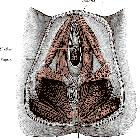coccygeus muscle
The coccygeus muscle, also known as the ischiococcygeus muscle, is a remnant muscle of the pelvic floor.
Gross anatomy
The coccygeus is a paired muscle which is triangular in shape and overlies the sacrospinous ligament. The coccygeus lies parallel to the inferior border of the piriformis muscle, but is separated from it by structures leaving the pelvis inferior to that muscle . Therefore, it forms the lowest part of the posterior wall of the lesser pelvis.
The coccygeus muscle is sometimes included within the levator ani muscle complex . Together with the levator ani, it forms the pelvic diaphragm .
Coccygeus contributes to the formation of the pelvic floor; therefore it functions to support pelvic viscera but also functions to pull the coccyx forward after defecation. In other species, its primary function is movement of the tail, however, in humans it is virtually replaced by ligamentous tissues.
Relations
Its gluteal surface is not muscle but fibrous tissue, which is formed by the sacrospinous ligament . Its pelvic surface is covered by the minute coccygeus plexus. This pierces the coccygeus and supplies the skin from the coccyx to the anus .
Attachments
Its origin is the tip of the ischial spine, adjacent to the posterior margin of the obturator internus and the pelvic surface of the sacrospinous ligament.
Its fibers fan out to insert into the lateral margin of the coccyx and the lowest piece of the sacrum. It lies adjacent to the lower border of the piriformis.
Blood supply
- arterial supply: inferior gluteal artery
Innervation
It is supplied by branches from the anterior rami of S4 and S5 .
Siehe auch:
und weiter:

 Assoziationen und Differentialdiagnosen zu Musculus coccygeus:
Assoziationen und Differentialdiagnosen zu Musculus coccygeus:
